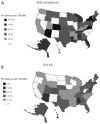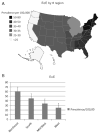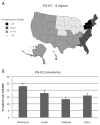Variation in prevalence, diagnostic criteria, and initial management options for eosinophilic gastrointestinal diseases in the United States
- PMID: 21057327
- PMCID: PMC4450826
- DOI: 10.1097/MPG.0b013e3181eb5a9f
Variation in prevalence, diagnostic criteria, and initial management options for eosinophilic gastrointestinal diseases in the United States
Abstract
Objectives: Variation in the prevalence of eosinophilic gastrointestinal diseases in different geographical regions has not been extensively studied. The aim of the present study was to define the regional and national prevalence of eosinophilic gastrointestinal diseases, and differences in practice approaches.
Patients and methods: We administered a survey electronically to members of the American College of Gastroenterology, the American Academy of Allergy, Asthma, and Immunology, and the North American Society Pediatric Gastroenterology, Hepatology, and Nutrition. Questions pertained to the number and proportion of patients seen with eosinophilic gastroenteritis or colitis and eosinophilic esophagitis (EoE), and methods used to diagnose and treat these conditions.
Results: A total of 1836 physicians responded from 10,874 requests (17% response). Extrapolating responses from our US sample, we estimated an overall prevalence of 52 and 28/100,000 for EoE and eosinophilic gastroenteritis or colitis. The patient burden of EoE is higher in urban (0.58) and suburban (0.44) compared with rural settings (0.36, P < 0.0065), observations consistent with other allergic disorders. There was also increased prevalence in northeast region when calculated by prevalence per 100,000. There was considerable variability in criteria and initial treatment options used to diagnose EoE. Only one-third of respondents reported using diagnostic criteria proposed in a 2007 consensus document. Seventy-one and 35% of respondents reported treating some patients with EoE with a food elimination or elemental diet, respectively.
Conclusions: EoE is diagnosed more often in northeastern states and urban areas. There is considerable variability in diagnostic criteria and initial treatment approach supporting the need for additional clinical trials and consensus development.
Conflict of interest statement
The authors report no conflicts of interest.
Figures



Similar articles
-
Eosinophilic Gastrointestinal Disorders.Clin Rev Allergy Immunol. 2019 Oct;57(2):272-285. doi: 10.1007/s12016-019-08732-1. Clin Rev Allergy Immunol. 2019. PMID: 30903439 Review.
-
Questionnaire Survey on the Diagnosis and Treatments of Eosinophilic Gastrointestinal Diseases in Asia.Digestion. 2025;106(2):153-164. doi: 10.1159/000544725. Epub 2025 Feb 13. Digestion. 2025. PMID: 39947169
-
Eosinophilic gastroenteritis: epidemiology, diagnosis, and treatment.Curr Opin Allergy Clin Immunol. 2020 Jun;20(3):311-315. doi: 10.1097/ACI.0000000000000635. Curr Opin Allergy Clin Immunol. 2020. PMID: 32073433 Review.
-
Clinical characteristics of Japanese patients with eosinophilic esophagitis and eosinophilic gastroenteritis.J Gastroenterol. 2013 Mar;48(3):333-9. doi: 10.1007/s00535-012-0640-x. Epub 2012 Jul 31. J Gastroenterol. 2013. PMID: 22847555
-
Prevalence of Eosinophilic Gastritis, Gastroenteritis, and Colitis: Estimates From a National Administrative Database.J Pediatr Gastroenterol Nutr. 2016 Jan;62(1):36-42. doi: 10.1097/MPG.0000000000000865. J Pediatr Gastroenterol Nutr. 2016. PMID: 25988554 Free PMC article.
Cited by
-
Split dose and MiraLAX-based purgatives to enhance bowel preparation quality becoming common recommendations in the US.Therap Adv Gastroenterol. 2013 Jan;6(1):5-14. doi: 10.1177/1756283X12464100. Therap Adv Gastroenterol. 2013. PMID: 23320046 Free PMC article.
-
The 2010-2015 Prevalence of Eosinophilic Esophagitis in the USA: A Population-Based Study.Dig Dis Sci. 2016 Oct;61(10):2928-2934. doi: 10.1007/s10620-016-4204-4. Epub 2016 Jun 1. Dig Dis Sci. 2016. PMID: 27250980 Free PMC article.
-
Case-control study of association of eosinophilic gastrointestinal disorders with Helicobacter pylori infection in Japan.J Clin Biochem Nutr. 2013 Jul;53(1):60-2. doi: 10.3164/jcbn.13-15. Epub 2013 Apr 19. J Clin Biochem Nutr. 2013. PMID: 23874072 Free PMC article.
-
TGFβ receptor mutations impose a strong predisposition for human allergic disease.Sci Transl Med. 2013 Jul 24;5(195):195ra94. doi: 10.1126/scitranslmed.3006448. Sci Transl Med. 2013. PMID: 23884466 Free PMC article.
-
Eosinophilic esophagitis: diagnostic tests and criteria.Curr Opin Gastroenterol. 2012 Jul;28(4):382-8. doi: 10.1097/MOG.0b013e328352b5ef. Curr Opin Gastroenterol. 2012. PMID: 22450900 Free PMC article. Review.
References
-
- Dellon ES, Aderoju A, Woosley JT, et al. Variability in diagnostic criteria for eosinophilic esophagitis: a systematic review. Am J Gastroenterol. 2007;102:2300–13. - PubMed
-
- Furuta GT, Liacouras CA, Collins MH, et al. Eosinophilic esophagitis in children and adults: a systematic review and consensus recommendations for diagnosis and treatment. Gastroenterology. 2007;133:1342–63. - PubMed
-
- Noel RJ, Putnam PE, Rothenberg ME. Eosinophilic esophagitis. N Engl J Med. 2004;351:940–1. - PubMed
-
- Straumann A. The natural history and complications of eosinophilic esophagitis. Gastrointest Endosc Clin N Am. 2008;18:99–118. ix. - PubMed
Publication types
MeSH terms
Supplementary concepts
Grants and funding
LinkOut - more resources
Full Text Sources
Medical

